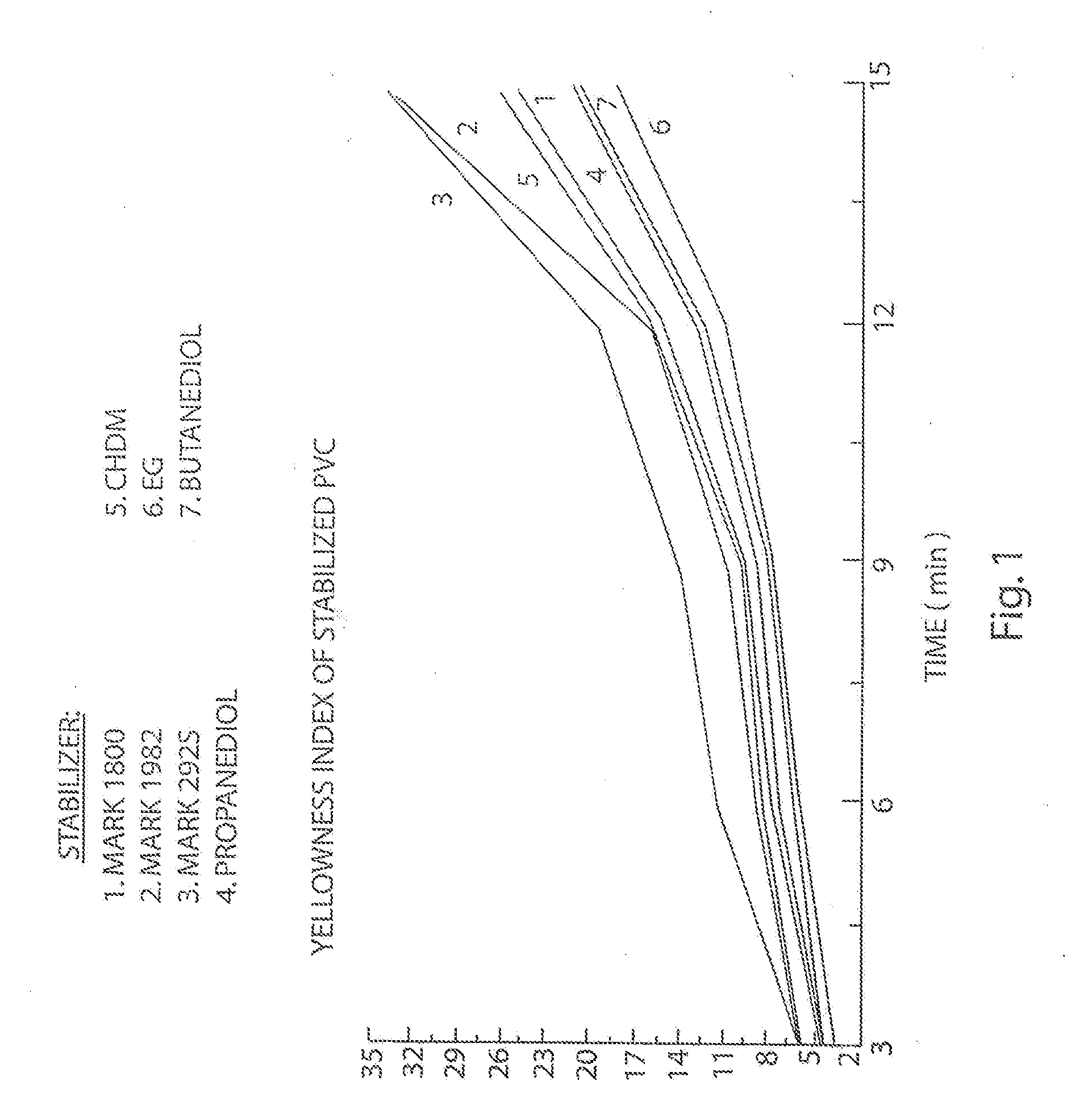Alkyltin Sulfanyl Mercaptocarboxylates Having Terminal Thiol Groups
a technology of thiol groups and alkyltin sulfanyl mercaptocarboxylates, which is applied in the field of alkyltin thermal stabilizers for halogen-containing resin compositions, can solve the problems of not providing experimental data to quantify the claims of any of these compounds, and achieves the effect of high shear for
- Summary
- Abstract
- Description
- Claims
- Application Information
AI Technical Summary
Benefits of technology
Problems solved by technology
Method used
Image
Examples
example 1
Synthesis of dimethyltin bis(1,2-ethane dithioglycolate)
[0028]62 g ethylene glycol was reacted with 191.2 g thioglycolic acid (TGA) in the presence of 1 g p-toluenesulfonic acid (p-TSA) at 110-150° C. Over a period of 5 hours, 34 g water was collected (theory water 36 g). The batch was neutralized with 5 g K2CO3 and filtered to yield 214 g of clear product. The acid value after neutralization was 0.051 meq / g. Mercaptan value by iodine titration was 28.74%. Gas chromatographic analysis showed no ethylene glycol and 12.6% mono-thioglycolate and 80% di-thioglycolate.
[0029]100.7 g of the di-thioglycolate (1,2-ethane dithioglycolate) was reacted with 50.13 g dimethyltin dichloride dissolved in 150 ml water. The reaction mix was neutralized to pH 6.5 using ammonium hydroxide solution. The crude product was separated from the aqueous phase and stripped at 80° C. and 2-5 mm Hg for 2 hours using a Buchi Rotovapor R-134 evaporator. The product was filtered hot to remove traces of residual sal...
example 2
Evaluation of Color Stability
[0031]Rigid PVC formulations were prepared using the stabilizer of Example 1, the control stabilizers derived from diols of higher (than ethylene glycol) molecular weight and commercially available alkyltin stabilizers, such as dimethyltin-bis(2-ethylhexylthioglycolate) (Mark 1982), dibutyltin-bis(2-ethylhexylthioglycolate) (Mark 292S), and a blend of monomethyltin-tris(2-ethylhexylthioglycolate) with dimethyltin-bis(2-ethylhexylthioglycolate) (Mark 1900). The tin content in the formulations was the same for all samples. Each PVC compound test sample was placed into a Brabender mixer operated at 190° C. and 65 RPM. Sample chips were taken every three minutes. Fusion time was about the same for all samples.
[0032]Color stability was determined from sample chips using a Hunter Lab colorimeter measuring Yellowness Index (YI) (lower YI signifies lesser discoloration as a result of thermal decomposition and, therefore, superior thermal stabilization). See Tabl...
PUM
| Property | Measurement | Unit |
|---|---|---|
| color stability | aaaaa | aaaaa |
| formulation | aaaaa | aaaaa |
| molar ratio | aaaaa | aaaaa |
Abstract
Description
Claims
Application Information
 Login to View More
Login to View More - R&D
- Intellectual Property
- Life Sciences
- Materials
- Tech Scout
- Unparalleled Data Quality
- Higher Quality Content
- 60% Fewer Hallucinations
Browse by: Latest US Patents, China's latest patents, Technical Efficacy Thesaurus, Application Domain, Technology Topic, Popular Technical Reports.
© 2025 PatSnap. All rights reserved.Legal|Privacy policy|Modern Slavery Act Transparency Statement|Sitemap|About US| Contact US: help@patsnap.com

